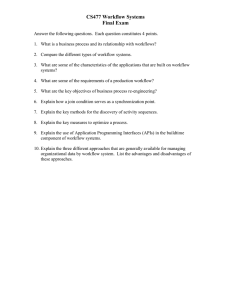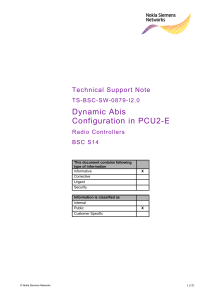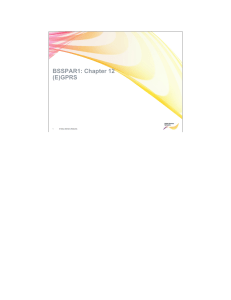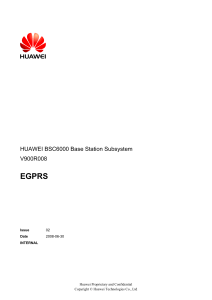User Interface of a GSM Capacity Analysis Tool
advertisement
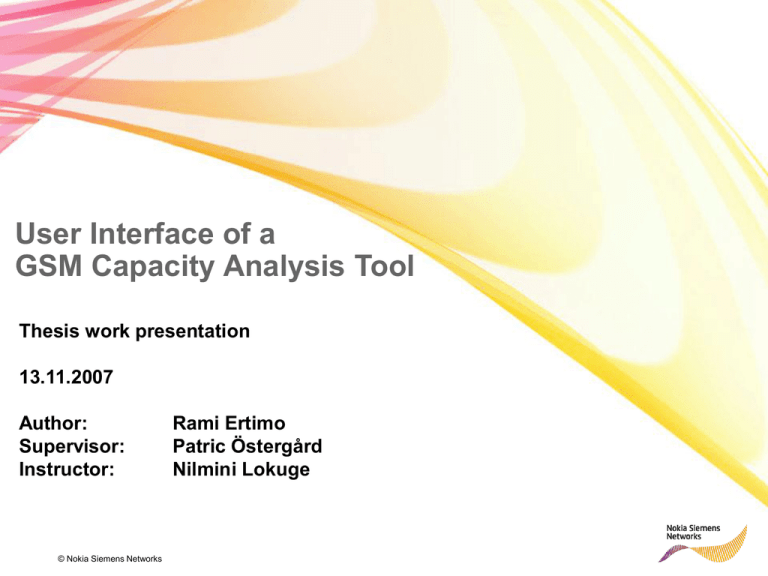
User Interface of a GSM Capacity Analysis Tool Thesis work presentation 13.11.2007 Author: Supervisor: Instructor: © Nokia Siemens Networks Rami Ertimo Patric Östergård Nilmini Lokuge Agenda • • • • • Introduction to the Study – Problem Setting, Objectives, Research Methods Capacity Analysis User Requirements User Interface Conclusions Problem setting • Fractured data spread across operators’ OSS related to EGPRS Capacity Analysis • Different bodies of the organisation involved in fixing different domains of the EGPRS network No view of the overall situation in the network • These causing inadequate network performance and loss of revenue. Objectives • Gather and categorise user requirements • Analyse user requirement to build a conclusive workflow to support the needed functions in Capacity Analysis • From the user requirements and workflow build a easy to use User Interface that seamlessly supports the workflow and also individual user requirements Research Methods • Literature study – Specification related to GSM, GPRS and EDGE (ITU, 3GPP) – Books related to usability, user-centered design, network optimisation, capacity analysis, EGPRS networks – Publications and web pages related to user interface creation and usercentered design. • Practical part – Gathering User Requirements (interviews, workshops) – Analysing User Requirements Creating User Stories – Iterating over: ▪ ▪ ▪ ▪ Prototyping Collecting feedback Revisiting design and prototype Ensuring end product design Agenda • • • • • Introduction to the Study – Problem Setting, Objectives, Research Methods Capacity Analysis User Requirements User Interface Conclusions GPRS/EDGE capacity analysis BSS BSC Applicatio n Servers 2G SGSN GGSN Radio Abis/EDAP PCU Gb Four Analysis Domains: Radio interface capacity analysis Abis interface EDAP pool size capacity analysis BSC/PCU capacity analysis Gb capacity analysis Application Servers in Internet Edge-2-Edge view for Capacity Analysis Reliability in trouble shooting • Performance decrease is usually seen in BTS KPIs even though the actual problem is elsewhere. • Tool should help in identifying the correct root cause of the problem Accuracy for dimensioning • When adding capacity see and understand the bottleneck domain and required size • Over dimensioning can be avoided and desired capacity can be ensured in whole chain Speed and easiness of all steps • Offer one view to see all the elements and interfaces • Highlight the capacity bottle necks and guide the user to over come the problem • Help to identifying the changes in one place cause any bottlenecks elsewhere Agenda • • • • • Introduction to the Study – Problem Setting, Objectives, Research Methods Capacity Analysis User Requirements User Interface Conclusions User Requirements • User Stories – – – – – – High-level definition of a requirement Short description of a piece of functionality told from the user perspective Focus on the user Leaves enough room for design Can typically be easily mapped to User Interface functionality Problems with text formed requirements They do not visualise the desired solutions in clear manner • Example: – “As a Network Planning Expert, I can modify the GPRS territory” Workflow Agenda • • • • • Introduction to the Study – Problem Setting, Objectives, Research Methods Capacity Analysis User Requirements User Interface Conclusions User Interface Demo about: 1. CM and PM Import 2. Visualisation features related to: • Navigator • • • Custom Labels, Capacity View Browser • Profiles, CM and PM parameters Map • Sites, Cell Icon, Cell Area, Parameters related to map 3. Preferences 4. Capacity Analysis • • E-2-E Analysis Different Domains Import and Preferences Overall User Interface Agenda • • • • • Introduction to the Study – Problem Setting, Objectives, Research Methods Capacity Analysis User Requirements User Interface Conclusions Conclusions • User Stories in addition with well defined workflow help in identifying missing features and gaps in the UI workflow • Truly user friendly and usable interface requires iteration over iteration over iteration • Centralised solution to analyse the whole BSS domain helps in the analysis capacity bottleneck and reduces operator OPEX and CAPEX. • Only the first step towards the right direction: – – – – – More automation needed Need to be proactive rather than reactive The radio domain is not sufficient for an End-2-End solution EGRPS network are being complemented with UMTS networks Many operators have multiple vendors Thank you Questions? © Nokia Siemens Networks




